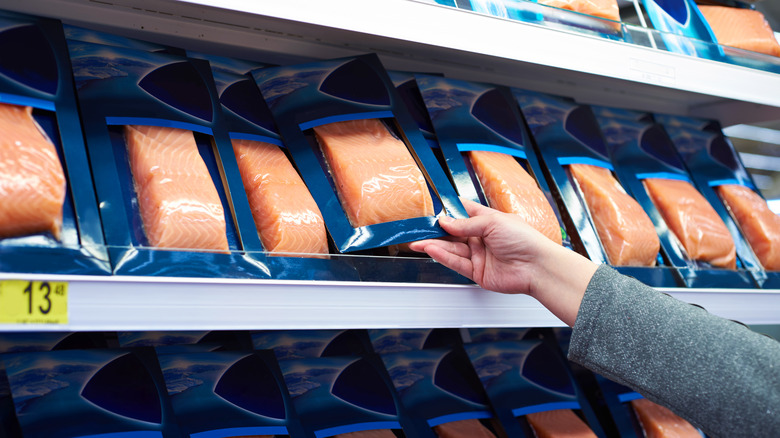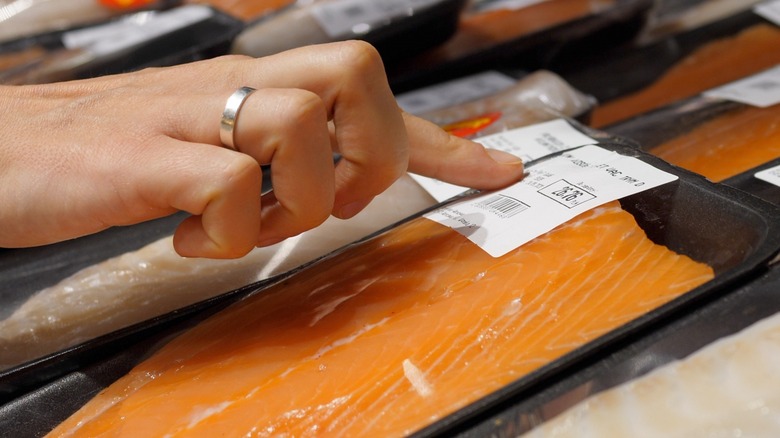The Packaging Red Flag That Might Mean Your Salmon Is Fraudulent
Consumers are pretty savvy these days, especially when it comes to food consumption. We seek out whole grains, check for GMOs, and research ingredients with long names we can't even pronounce. Informational labels are more prevalent than ever, thanks to consumer protection agencies such as the USDA, the FDA, and various other departments. Yet still, when it comes to seafood, there's a thing known colloquially as "fish fraud."
This basically refers to the practice of misrepresenting the fish being sold, either intentionally or accidentally. Given the high percentage of seafood in America arriving from international locations, it's hardly surprising that a fish's origins, species, and means of cultivation get a little fuzzy by the time it lands in local markets. So, we rely heavily on packaging labels and the integrity or knowledge of whoever created those labels. But should we give blanket trust without at least a cursory knowledge of what to look for on the label? Probably not.
Instead, knowing how to read labels can put your mind at ease and perhaps even save you some money at checkout. For example, why pay premium dollars for wild-caught king salmon from Alaska if it was actually farm-raised in Atlantic salmon pens? As one of the most popular types of seafood sold in America, salmon is particularly vulnerable to mislabeling. A few red flags can indicate whether you're buying the salmon you think you are, one of the primary ones being a failure to identify which particular type of wild salmon is in the package.
How to spot fraudulent salmon labeling
Fraudulent labeling can occur at any stage of salmon processing, from at-sea boat transfers to wholesaler shipping to retailer re-packaging for individual sales. It can also happen when you're ordering salmon at seafood restaurants, especially if there's no mention of the specific type of salmon being sold or served. That's a red flag, especially if the label or menu claims that it's wild-caught rather than farm-raised salmon. If that distinction is important to you, it helps to know the main types of wild salmon.
The five primary categories of Pacific wild-caught salmon available in America include sockeye, coho, pink, chum, and chinook, also called king salmon. If the packaging fails to identify the type, be wary of its authenticity. It would be like buying produce labeled simply "lettuce" rather than specifying romaine, iceberg, or arugula. Farmed salmon most commonly comes from the Atlantic rather than the Pacific region. In fact, strict regulations on commercial and recreational wild sea-run Atlantic salmon pretty much guarantee that labels claiming "wild-caught Atlantic" are fraudulent.
If you can get a look at the whole fish, a salmon's tail will tell you if it was wild-caught. Look for a large, fan-shaped tail earned from a life of swimming in open waters. The flesh will also be a darker red with less white fat marbling. Another thing to look for in labeling fraud is what's called short-weighing. If a package claims 5 ounces but the salmon has an unusual amount of glazing, looks water-bloated, or is packed in a lot of ice for preservation, you could be paying for that excess. Also, be wary of pre-cut, pre-weighed salmon filets labeled with the same set price. You might want to compare them side by side, or ask to have yours individually weighed.

